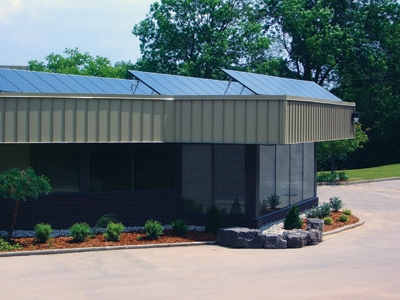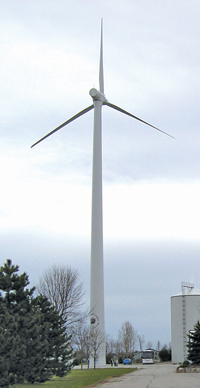
Features
Efficiency
Energy
Energy still a hot button issue
March 9, 2012 By Chris Chanlon Michelle Vieira
 Ag Energy Co-operative installed solar panels at its offices in Guelph, Ontario.
Ag Energy Co-operative installed solar panels at its offices in Guelph, Ontario. Reviewing risk management, purchasing strategies, billing issues, conservation, and efficiency
Welcome to the inaugural Energy Matters column. Since energy usually ranks in the top three operating expenses for greenhouses, its impact on the bottom line is substantial.
Energy conservation and efficiency, together with environmental responsibility, are certainly today’s hot button issues, apart from the economy. When you pick up the daily newspaper or a magazine, it is sure to feature predictions on global warming and provide lists of energy-saving tips. It is good to take advantage of those tips by addressing the low hanging fruit – install motion sensor lights in rarely used areas, weatherstrip doors and windows, turn off power bars to save phantom electricity loads, and so on.
But greenhouse crops have specific heat and light requirements that cannot be ignored, and these operations are much more complicated. At this point, many growers throw their hands in the air and ask what else can they do?
With that in mind, it is our intention to address different matters of energy and its management in this and future columns. We will discuss risk management, purchasing strategies, commodity
and billing issues, as well as conservation and efficiency measures that positively contribute to business sustainability.
 |
| What’s your best energy option? |
 |
WHAT NEW TECHNOLOGY WILL WORK BEST FOR WHOM?
■ The most commonly voiced concerns in the greenhouse industry are a lack of time and expertise due to an overwhelming number of new technologies in the marketplace that claim superiority over other technologies. Another issue is the influx of energy marketers approaching your business. In many cases, growers wonder where to start or who to believe. A good rule of thumb is that if you didn’t ask them to come and see you, then you should probably run the other way and quickly.
So let’s get started with a few first steps to effectively managing your energy . . . .
The single most important step is to appoint an “energy champion.” Someone has to be responsible to make sure things get done! It is not necessary for your champion to be an energy expert; all that is required is that your champion brings in the experts as needed, oversees projects, and tracks the results. Your energy champion should be someone who has the owner’s support to make changes.
Once you have your energy champion, what next? The old adage of “what you can measure, you can manage” was never truer than when applied to energy. You need to get a handle on all your energy usage. Accepting energy as simply an inevitable cost of doing business is a big mistake. Knowing how, when, where and why you consume each type of energy prioritizes areas that require attention and leads to maximizing the efficiency of your operation. Once you begin to know your energy use, you can then start to evaluate what you can change and how you can reduce your energy use.
BENCHMARKING HIGHLIGHTS OTHER EFFICIENCY OPPORTUNITIES
■ It is a good idea to benchmark your starting point because it establishes a baseline of your current energy use and enables you to track the results of the changes made. Benchmarking, or comparing your usage to others or yourself over time, helps highlight further efficiency opportunities. Also, the information captured to benchmark your usage is often necessary to qualify for project incentives, rebates or funding. You can complete this important step in house using your energy champion or have it outsourced to ensure its completion and execution.
When evaluating your energy usage, exercise caution to make sure that your whole operation is taken into consideration. Look at all forms of energy, all your systems and operations, how it all fits together, and most importantly, what the impacts on crop productivity may be. While there are some benefits to be realized by looking at just heat or just electricity, it is comparable to performing a house audit and only looking at the front windows; it’s better than nothing but not nearly as good as it could be. By looking at the entire picture, you can identify a broader range of possible initiatives as well as cost savings opportunities on proposed projects.
Strategic energy management need not be intimidating, but it can be complicated. The best approach is like the old “how do you eat an elephant” joke – one bite at a time. You don’t have to do everything all at once, you just have to do something and the good news is you don’t have to do it alone. ■
 |
Chris Chanlon is the Director of Energy Services for Ag Energy Co-operative, and is an engineer with over 25 years’ energy management experience. He can be contacted at chanlon@ag-energyservices.ca.
 |
Michelle Vieira is the Sales and Member Relationship Manager for Ag Energy Co-operative, and has over 12 years of energy industry experience. She can be contacted at mvieira@agenergy.coop.
Print this page